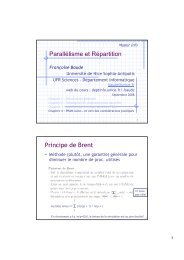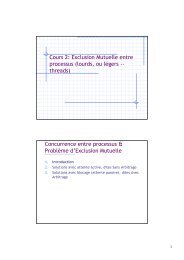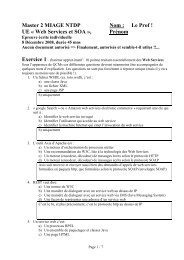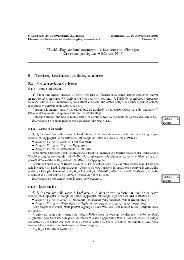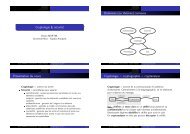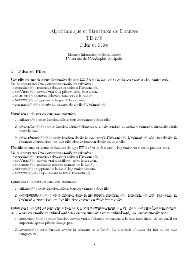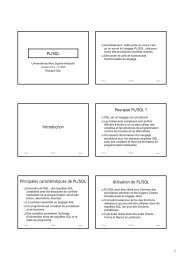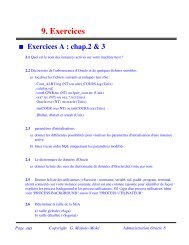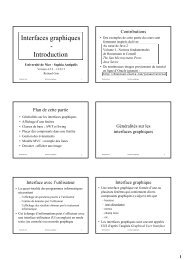TikZ and pgf
TikZ and pgf
TikZ and pgf
You also want an ePaper? Increase the reach of your titles
YUMPU automatically turns print PDFs into web optimized ePapers that Google loves.
• Reference the graphic in your main text as in “For an example of quicksort ‘in action,’ see Figure 2.1<br />
on page xyz.”<br />
• Most books on style <strong>and</strong> typography recommend that you do not use abbreviations as in “Fig. 2.1”<br />
but write “Figure 2.1.”<br />
The main argument against abbreviations is that “a period is too valuable to waste it on an abbreviation.”<br />
The idea is that a period will make the reader assume that the sentence ends after “Fig” <strong>and</strong><br />
it takes a “conscious backtracking” to realize that the sentence did not end after all.<br />
The argument in favor of abbreviations is that they save space.<br />
Personally, I am not really convinced by either argument. On the one h<strong>and</strong>, I have not yet seen any<br />
hard evidence that abbreviations slow readers down. On the other h<strong>and</strong>, abbreviating all “Figure” by<br />
“Fig.” is most unlikely to save even a single line in most documents.<br />
I avoid abbreviations.<br />
4.5 Consistency Between Graphics <strong>and</strong> Text<br />
Perhaps the most common “mistake” people do when creating graphics (remember that a “mistake” in<br />
design is always just “ignorance”) is to have a mismatch between the way their graphics look <strong>and</strong> the way<br />
their text looks.<br />
It is quite common that authors use several different programs for creating the graphics of a paper. An<br />
author might produce some plots using gnuplot, a diagram using xfig, <strong>and</strong> include an .eps graphic a<br />
coauthor contributed using some unknown program. All these graphics will, most likely, use different line<br />
widths, different fonts, <strong>and</strong> have different sizes. In addition, authors often use options like [height=5cm]<br />
when including graphics to scale them to some “nice size.”<br />
If the same approach were taken to writing the main text, every section would be written in a different<br />
font at a different size. In some sections all theorems would be underlined, in another they would be printed<br />
all in uppercase letters, <strong>and</strong> in another in red. In addition, the margins would be different on each page.<br />
Readers <strong>and</strong> editors would not tolerate a text if it were written in this fashion, but with graphics they<br />
often have to.<br />
To create consistency between graphics <strong>and</strong> text, stick to the following guidelines:<br />
• Do not scale graphics.<br />
This means that when generating graphics using an external program, create them “at the right size.”<br />
• Use the same font(s) both in graphics <strong>and</strong> the body text.<br />
• Use the same line width in text <strong>and</strong> graphics.<br />
The “line width” for normal text is the width of the stem of letters like T. For TEX, this is usually<br />
0.4 pt. However, some journals will not accept graphics with a normal line width below 0.5 pt.<br />
• When using colors, use a consistent color coding in the text <strong>and</strong> in graphics. For example, if red is<br />
supposed to alert the reader to something in the main text, use red also in graphics for important parts<br />
of the graphic. If blue is used for structural elements like headlines <strong>and</strong> section titles, use blue also for<br />
structural elements of your graphic.<br />
However, graphics may also use a logical intrinsic color coding. For example, no matter what colors<br />
you normally use, readers will generally assume, say, that the color green as “positive, go, ok” <strong>and</strong> red<br />
as “alert, warning, action.”<br />
Creating consistency when using different graphic programs is almost impossible. For this reason, you<br />
should consider sticking to a single graphic program.<br />
4.6 Labels in Graphics<br />
Almost all graphics will contain labels, that is, pieces of text that explain parts of the graphics.<br />
placing labels, stick to the following guidelines:<br />
When<br />
• Follow the rule of consistency when placing labels. You should do so in two ways: First, be consistent<br />
with the main text, that is, use the same font as the main text also for labels. Second, be consistent<br />
between labels, that is, if you format some labels in some particular way, format all labels in this way.<br />
40






